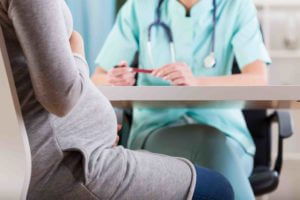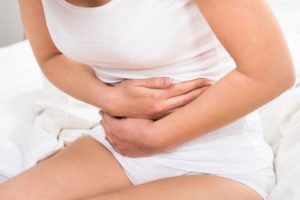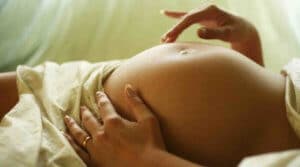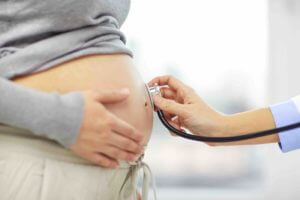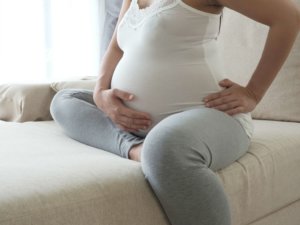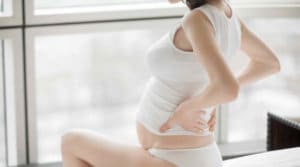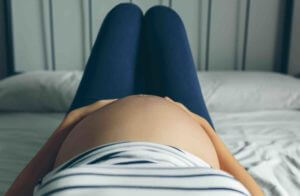Table of contents
The Mother Ligaments – Interesting Facts & Practical Tips For Stretching Pain
Pulling abdominal pain is often caused by stretching of the uterine ligaments. In most cases, there is no reason to worry regarding these typical complaints, but they often cause a great deal of uncertainty, especially among first-time mothers. Are these complaints normal or should you be worried if you notice certain signs? Find out now – in this article, we’ll tell you interesting facts and give you practical tips on how to alleviate the pain.
The course and function of the uterine ligaments
The uterine ligaments (ligamenta) are made of muscle fibers and belong to the parametria (pelvic connective tissues), which can also be considered as the attachment apparatus of the uterus. They run on both sides from your uterus to the pubic bone and serve to stabilize the uterus. During pregnancy, the ligaments are subjected to great stress due to the strong growth of your uterus
Stretching of the uterine ligaments (ligamentum latum uteri and ligamentum teres uteri) occurs. Strong tensile forces act on all the tissue in the abdomen. The round uterine ligament (ligamentum teres uteri) resembles a classic tendon and extends on both sides from the upper third of the uterus past the ovaries through the inguinal canal to the labia majora
At the lower third of the uterus, the broad uterine ligament (ligamentum latum uteri) begins in the posterior region. It resembles a wider woven cloth and runs from both sides down into the posterior region to the respective lateral edge of the pelvic wall. The tensile forces due to the stretching of the uterine ligaments during pregnancy also affect the pelvic wall and inguinal canal.
Also interesting:
Stretching pain during pregnancy
If you already suffer from pulling pain in the groin area on both sides at the beginning of your pregnancy, in most cases, this is not a cause for concern. It is quite possible that this discomfort originates from the maternal ligaments. Most often, this pain is associated with the general changes that, starting from the uterus, also affect the surrounding tissues. During pregnancy, the uterus increases its volume about a hundred times
Therefore, it is not surprising that as the pregnancy progresses, painful discomfort may also occur more frequently due to the high stress on the uterine ligaments. From about the 17th week of pregnancy, stretching pain can occur more frequently, which manifests itself as pulling in the lower abdomen. However, the time for the first occurrence of this uterine ligament pain may well be as late as the 19th or 20th week of pregnancy. The uterine ligaments expand as the uterus grows, so dull, pulling and often stabbing pains are quite normal and not uncommon
Most of the time you will feel this discomfort due to the stretching of the uterine ligaments on both sides of the lower abdomen. Sometimes expectant mothers also complain of painful pulling that can spread to the sacrum. These complaints are also favored by the movements of the growing child, which you can usually feel between the 20th and 23rd week of pregnancy
They also have a stressful effect on the maternal ligaments, which are already under a lot of strain. Another aspect is the hormonal changes in your body that cause the maternal ligaments to loosen during pregnancy. This can also contribute to the development of back pain, and many pregnant women complain of a persistent pulling down to the sacrum.
Stretching pain or preterm labor?
Even though these pulling pains in the groin area are rather unpleasant, they do not usually indicate serious illnesses in any way. They are harmless side effects of normal development during pregnancy. They usually disappear after the end of the 24th week of pregnancy, so they will not accompany you until the due date. However, if you suffer from particularly severe pain, it is advisable to contact your midwife or gynecologist. However, if you suffer from particularly severe pain, it is advisable to contact your midwife or your gynecologist (if you don’t have one yet, you can use portals such as www.frauenarte-im-netz.de.)
A simple examination can then safely determine whether it is normal pain in the lower abdomen due to the stretching of the maternal ligaments or whether preterm labor is present. If you also notice that your abdomen hardens when the painful discomfort occurs and then softens again, caution is advised, as this may be a sign of preterm labor. On the other hand, it is quite normal for your abdomen to become hard from time to time during pregnancy. These are usually so-called exercise contractions. They already occur in early pregnancy, usually, you will feel them around the 20th to 25th week of pregnancy
However, unlike preterm labor and labor pains, exercise contractions are painless and usually occur irregularly. They are used to prepare for delivery and there is no opening of the cervix. However, if pain and/or bleeding occur, you should see your gynecologist. Especially if you have been diagnosed with a high-risk pregnancy, you should not take any risks and better consult your gynecologist immediately. In a high-risk pregnancy, there may be high risks for mother and child due to premature labor. A visit to the doctor is also advisable if the painful symptoms suddenly worsen and/or other problems such as vomiting, diarrhea, and fever occur.
Also interesting:
Descending contractions – countdown to the birth date
After stretching pains and exercise contractions, as your due date approaches, you’ll also be faced with descending contractions. As you enter the home stretch of your pregnancy, your uterus is also preparing for the big day. From around the 35th to 37th week of pregnancy, the now-familiar practice contractions turn into low contractions and slowly move your baby towards the birth canal. Every woman experiences these irregular descending contractions in a different way. Sometimes they are barely noticeable and can only be identified by the lowering of your belly
However, there may also be varying degrees of labor pain and pulling in the abdomen, back, and groin. Noticeable contractions are also possible. If the discomfort lasts longer or becomes more severe and you feel uncomfortable, you should see your gynecologist be sure. Again, if you have a high-risk pregnancy, be especially careful – out of consideration for your child and your own health, you should not shy away from frequent visits to your gynecologist.
Tips for relieving stretching pain
If you are suffering from stretching pain due to the strong pulling forces caused by the stretching of the uterine ligaments (ligamenta), there are some tips that can give you relief. The uterus, the pelvic wall, the inguinal canal, and especially the round as well as the wide uterine ligament (ligamentum latum uteri and ligamentum teres uteri) are subjected to strong stresses and you may be plagued by uncomfortable discomfort that can extend to the sacrum. With the tips below, you can provide relief and benefit from pain relief:
Rest
A short time off can sometimes work wonders. Choose a relieving rest position in bed or on the sofa and give your body a little break. The supine position is particularly recommended for relieving the strain on the maternal ligaments. This provides effective relief for the maternal ligaments and promotes relief.
Heat
For period pain, heat can provide relief – even for stretching pain caused by the uterine ligaments, a bath in warm bath water provides soothing relaxation. Also helpful is a heating pad or the classic hot water bottle.
Massage
In case of discomfort caused by the strained maternal ligaments, you can counteract the unpleasant discomfort with a massage. It is recommended to use essential massage oils (rosewood, lavender, chamomile, etc.). If the discomfort is particularly painful, and oil compress in the groin area can help.
Relief
As your baby’s belly grows, you can relieve pressure on the maternal ligaments and strained tissues during the day by wearing a special belly cloth or support band. During the night, however, you should take off this relief aid for the maternal ligaments to ensure optimal blood circulation.
So if you suffer from unpleasant stretching pains, it is only the maternal ligaments that are responsible. They are subjected to great stress and yet provide the important stability of your uterus. This discomfort may be unpleasant, but on the other hand, it is a sign that your pregnancy is progressing normally.

